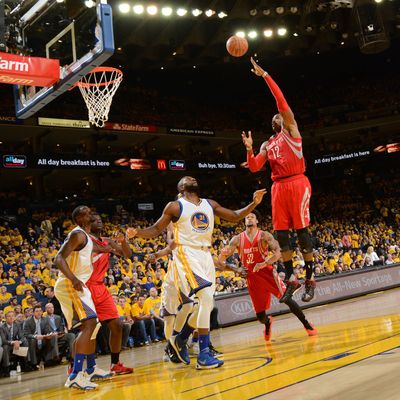
Dwight Howard has a problem. As Deadspin noted yesterday, the all-star Houston Rockets center revealed in a recent interview with ESPN’s Jackie MacMullan that he is scared of taking jump shots, because what if he misses them?
Here’s the excerpt Deadspin pulled:
Howard: “I used to shoot 1,000 shots a day. I called Kobe when I was still playing in Orlando and asked him what I should do. He’s the one who told me to do take 1,000 a day. So I’d practice and practice them but then I’d be so afraid to take them in a game because I was so worried I would miss. I hate messing up. I hate failure. I was just talking to (WNBA) star Tina Thompson the other day about it. I told her about my fear of missing and she said, ‘Dwight, you’re gonna miss. Everyone does.’ But I want to be perfect.’’
ESPN: So you don’t take perimeter jumpers because you are afraid you will miss them?
Howard: “I don’t like messing up. I didn’t want to turn on the TV and see people say, ‘Dwight is taking all those outside shots, he’s screwing around, he doesn’t care, he doesn’t want to win.’ So that’s the war I’ll be having in my head. I’m working on it. I have a sports psychologist I used in Houston and I have one in Minnesota. If my spiritual and mental game is right, the physical part will follow.’’
Suffice it to say, this is a problem for an NBA player — particularly these days, when even big, bruising centers like Howard are expected to have jump-shot range out to 15 feet or so, and to take those shots when they’re open.
And it’s an interesting sort of problem, since it differs from the sports-psychology problems we’re used to hearing about. Usually, an athlete has a problem doing a task well: a basketball player can’t hit free throws; a baseball player strikes out too much; a wide receiver keep dropping catchable passes. Howard’s dilemma is different: He’s apparently so caught in his head about shooting jumpers that he doesn’t even want to try.
I was curious how a sports psychologist would handle a case like this, so I reached out to the Association for Applied Sport Psychology, and they put me in touch with two experts: Dr. Eddie O’Connor, a clinical psychologist and public speaker in Grand Rapids, Michigan, and Dr. Charlie Maher, a sport psychologist who has worked with athletes in all four major American sports, and is currently with the Cleveland Indians.
Both O’Connor and Maher said that the first step would be developing a rapport with Howard by explaining that they understand where his fear is coming from. “I would start by taking his side and agree with his perfectionism,” said O’Connor. “Mistakes aren’t okay. Missed shots cost the team opportunities to score points. He gets paid to make baskets and win games, so telling him (or any other athlete) that mistakes are okay isn’t really telling the whole truth. They aren’t going to believe it. The fact that ‘everyone misses’ isn’t going to help.” O’Connor explained that this would be his opening message to Howard partly because “You don’t want to start off arguing their feelings or challenging their perspective. But most of all I say it because it is absolutely true.” Professional athletes are expected to perform at a high level, in other words.
“Next, in a collaborative manner, often with the coach, the athlete is taught and guided to use his or her thoughts, emotions, and actions in the following way,” said Maher, laying out his recommended system:
* M — Maintain consistent contact with the present the moment and on the process of executing the task to which they are overly-concerned, including going through mindful practice of the task (no floating to past or future);
* A – Accept the reality that, as they practice and execute the task, they will feel uncomfortable but that they can just accept the discomfort and not buy into it (no self-judging); and,
* C — Commit to the task at hand and the process of playing the game, not on outcomes (no doubting).
There is, of course, a lesson here even for those of us who are not seven-foot-tall pro-basketball players. A lot of people engage in what psychologists call self-handicapping — putting less-than-full effort into something out of a desire to evade the possibility of failure, because if failure does occur it can then be chalked up to that lack of effort: “I wasn’t really trying, anyway.” It takes courage to actually try your hardest to do something you care about, because it can hurt if you don’t get what you want.
That’s why both O’Connor and Maher’s would-be advice to Howard includes elements of mindfulness, of staying in the present moment, and not letting your thoughts spiral out of control. Whether you’re taking a jump shot, writing a novel, or gunning for a promotion at work, all you can really do is try — try, and accept that fear is just part of the package deal of being alive.




